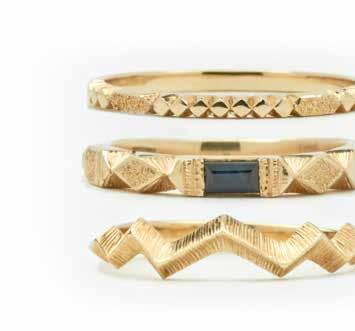
3 minute read
Member Profile
The self-taught Brightonbased jeweller is this year’s deserving winner of The Jewellery Cut Bursary.
As part of the bursary’s benefits, Jasmine received a place at the recent Jewellery Cut Live, a Fuli Gemstones peridot to be set in a future design and, we’re very happy to say, a year’s NAJ membership.
Advertisement
Other prizes were bestowed by Goldsmiths’ Fair, the Goldsmiths’ Company Assay Office, Retail Jeweller magazine, Honest PR, the De Beers Group Maidenhead lab and De Beers Diamond Institute and mentoring support from The Jewellery Cut founders.
Introducing Jasmine Ataullah
Commenting on Jasmine’s win, The Jewellery Cut founder Rachael Taylor said: “What drew the judges to Jasmine was her raw talent. Despite being mostly self-taught, she has built up a wide range of hand skills to a really high standard. We also loved her strong aesthetic and how she has blended her heritage and South Asian jewellery motifs with a fresh, modern style that has won her a dedicated following.”
To learn more about her journey, we found time to speak to Jasmine at the show.
What led you to becoming a designer maker?

It was never a decision as such, it was more of a natural progression that started with a course in silversmithing, and then having to make money to fund that continuation. I’ve sold my works since I began making – it’s always been a bit of a hustle. I was working in graphic design and wanted to explore more hands-on craft. I saw the course application for silversmithing and got really excited; I’d never worked with metal before and knew nothing about the processes, so everything was very new to me. A 12-week evening class at a local college taught me the basics, and I saved up cash for a setup at home. I hadn’t considered trying to get experience from other jewellers at the time, I just loved making pieces for myself and friends. The metal, the acid, the flames! The whole process invigorated me.
Did that lead to jewellery making full-time?
Yes, that happened pretty quickly. My partner and I went to live in New Zealand, he made me a bench in the back of our van, and I sold my work online to help fund our trip. Back in England, I was hyper focused, and as I got further into my journey, I realised I needed to invest in my skills to create the pieces I had in mind. I’m mainly self-taught, having learnt through trial and error, but I set aside cash for a weekend course with the Hand Engravers Association, as well as some oneto-one lessons in stone setting with a local jeweller. Because I haven’t had the pleasure of working under experienced jewellers, it took me a while to understand workshop ins and outs. Basic things like casting, I didn’t get my head round until a few years ago.
What have been your main challenges so far?
There are many. It’s been very important to understand how each process works, from carving to engraving to setting. Currently, I do all of them myself, and I make everything from a combination of lost-wax and hand-fabrication methods. Time is my main challenge. I’m generally learning on the job, and I want to understand it all, so I can be slow. Getting a piece from my mind to the point of purchase can take a lot longer than anticipated. I’m quite traditional in my approach, and my most recent achievements have been learning to make my own hinges and threaded wires for my piercing jewellery. That took me almost a year to get right!
What are your design inspirations?
My work is steeped in heritage. Being British and Pakistani, I find my pieces take on aspects of South Asian architecture, textiles and adornment practices. My ring collection is an ode to mehndi (henna). I wanted to create permanent pieces that emulate the intricacies of mehndi through bands of gold and engraving. Some of my work takes inspiration from pieces passed down on my British side, for example the Vida ring is a reincarnated version of a ring my Great Aunt Vida once wore.
I love working with stones from South Asia, mainly tourmalines from Afghanistan and Pakistan and sapphires from India and Sri Lanka. Gold is very much appreciated by South Asians, with identity, beautification and medicine all contributing to its social and cultural significance. Honouring that in my work is very important to me.










